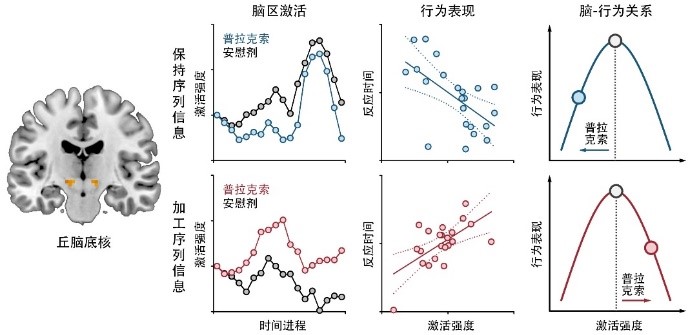Time:2022-11-10
A recent study published in Neuropsychopharmacology demonstrated that the dopamine D2/3 receptor agonist pramipexole modulates the fronto-subthalamic pathway during sequential working memory. This work was performed by researchers in Dr. YE Zheng’s Lab at the Institute of Neuroscience, Center for Excellence in Brain Sciences and Intelligence Technology of the Chinese Academy of Sciences, and Prof. Thomas MUENTE’s team at the Department of Neurology, University of Lübeck.
The ability to maintain and manipulate sequential information online is essential for a broad spectrum of daily activities, from making a conversation (what to say first) to scheduling a day (what to do first). Dopaminergic deficiency in Parkinson’s disease may lead to difficulties in sequential tasks. Patients with Parkinson’s disease often exhibit difficulties in understanding stories that are told backward and planning sequential steps to solve a problem. In their previous work, the researchers found that sequential working memory deficits in Parkinson’s disease correlate with hyper-activation of the subthalamic nucleus and abnormal fronto-subthalamic functional connectivity.
To better understand the dopaminergic mechanisms of sequential working memory, the researchers performed a double-blind, randomized, cross-over psychopharmacological study in 26 healthy volunteers. They measured the behavioral performance of sequential working memory and activity patterns of the fronto-subthalamic pathway.
The researchers found that pramipexole impacted the maintenance and manipulation of sequential information. It downregulated the subthalamic and dorsolateral prefrontal activity, increasing reaction times for maintaining sequences. In contrast, it upregulated the subthalamic and dorsolateral prefrontal activity, increasing reaction time costs for manipulating sequences. In addition, pramipexole altered the dorsolateral prefrontal activity pattern similarity and fronto-subthalamic functional connectivity.
This work entitled “Pramipexole modulates fronto-subthalamic pathway in sequential working memory” has been published online in Neuropsychopharmacology on November 9, 2022. Dr. Marcus HELDMANN at the University of Lübeck, is the first author. Prof. Thomas MUENTE at the University of Lübeck and Dr. YE Zheng at the Institute of Neuroscience, Center for Excellence in Brain Sciences and Intelligence Technology of the Chinese Academy of Sciences are co-corresponding authors. This work was supported by the National Natural Science Foundation of China and the Ministry of Science and Technology of China.

Figure legend: Schematic diagrams of pramipexole's impact on subthalamic activity and behavioral performance, and brain-behavior relationships.
Original article: to be added
Keywords: Dopamine D2 receptor, pramipexole, dorsolateral prefrontal cortex, subthalamic nucleus, sequential working memory, magnetic resonance imaging
AUTHOR CONTACT:
YE Zheng
Institute of Neuroscience, Center for Excellence in Brain Sciences and Intelligence Technology, Chinese Academy of Sciences, Shanghai, China.
E-mail: yez@ion.ac.cn
 附件下载:
附件下载: